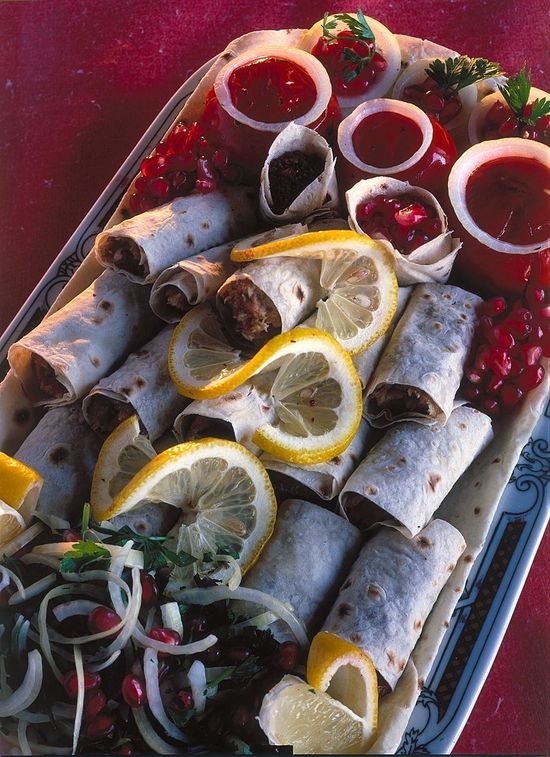A cuisine is a style of cooking characterized by distinctive ingredients, techniques and dishes, and usually associated with a specific culture or geographic region. A cuisine is primarily influenced by the ingredients that are available locally or through trade. Religious food laws, such as Hindu, Islamic and Jewish dietary laws, can also exercise a strong influence on cuisine. Regional food preparation traditions, customs and ingredients often combine to create dishes unique to a particular region
Cuisine
Global cuisine
A global cuisine is a cuisine that is practiced around the world, and can be categorized according to the common use of major foodstuffs, including grains, produce and cooking fats.

Regional cuisines
Regional cuisines can vary based on availability and usage of specific ingredients, local cooking traditions and practices, as well as overall cultural differences.[9] Such factors can be more-or-less uniform across wide swaths of territory, or vary intensely within individual regions. For example, in Central and South America, corn (maize), both fresh and dried, is a staple food, and is used in many different ways. In northern Europe, wheat, rye, and fats of animal origin predominate, while in southern Europe olive oil is ubiquitous and rice is more prevalent. In Italy, the cuisine of the north, featuring butter and rice, stands in contrast to that of the south, with its wheat pasta and olive oil. In some parts of China, rice is the staple, while in others this role is filled by noodles and bread. Throughout the Middle East and Mediterranean, common ingredients include lamb, olive oil, lemons, peppers, and rice. The vegetarianism practiced in much of India has made pulses (crops harvested solely for the dry seed) such as chickpeas and lentils as important as wheat or rice. From India to Indonesia, the extenive use of spices is characteristic; coconuts and seafood are also used throughout the region both as foodstuffs and as seasonings.
African cuisines use a combination of locally available fruits, cereal grains and vegetables, as well as milk and meat products. In some parts of the continent, the traditional diet features a preponderance of milk, curd and whey products. In much of tropical Africa, however, cow's milk is rare and cannot be produced locally (owing to various diseases that affect livestock). The continent's diverse demographic makeup is reflected in the many different eating and drinking habits, dishes, and preparation techniques of its manifold populations.
Cuisines of the Americas
The cuisines of the Americas are found across North and South America, and are based on the cuisines of the countries from which the immigrant people came, primarily Europe. However, the traditional European cuisine has been adapted by the addition of many local and native ingredients, and many techniques have been added to traditional foods as well. Native American cuisine is prepared by indigenous populations across the continent, and its influences can be seen on multi-ethnic Latin American cuisine. Many staple foods eaten across the continent, such as Corn, Beans, and Potatoes have native origins. The regional cuisines are North American cuisine, Mexican cuisine, Central American cuisine, South American cuisine, and Caribbean cuisine.
Asian cuisine
Asian cuisines are many and varied. Ingredients common to many cultures in the east and Southeast regions of the continent include rice, ginger, garlic, sesame seeds, chilies, dried onions, soy, and tofu. Stir frying, steaming, and deep frying are common cooking methods. While rice is common to most Asian cuisines, different varieties are popular in the various regions; Basmati rice is popular in the South Asia, Jasmine is often found across the southeast, while long-grain rice is popular in China and short-grain in Japan and Korea.[11]Curry is also a common dish found in southern and eastern Asia, however they are not as popular in western Asian cuisines.
European cuisine
European cuisine (alternatively, "Western cuisine") include the cuisines of Europe and other Western countries. European cuisine includes that of Europe and to some extent Russia, as well as non-indigenous cuisines of North America, Australasia, Oceania, and Latin America. The term is used by East Asians to contrast with Asian styles of cooking.[13] This is analogous to Westerners referring collectively to the cuisines of Asian countries as Asian cuisine. When used by Westerners, the term may refer more specifically to cuisine in Europe; in this context, a synonym is Continental cuisine, especially in British English.
Oceanian cuisine
Oceanian cuisines include Australian cuisine, New Zealand cuisine, Tasmanian cuisine, and the cuisines from many other islands or island groups throughout Oceania. Australian cuisine consists of immigrant European cuisine, and Bushfood prepared and eaten by native Aboriginal Australian peoples, and various newer Asian influences. New Zealand cuisine also consists of European inspired dishes, such as Pavlova, and native Maori cuisine. Across Oceania, staples include the Kumura (Sweet potato) and Taro, which was/is a staple from Papua New Guinea to the South Pacific. On most islands in the south pacific, Fish are widely consumed because of the proximity to the ocean.


